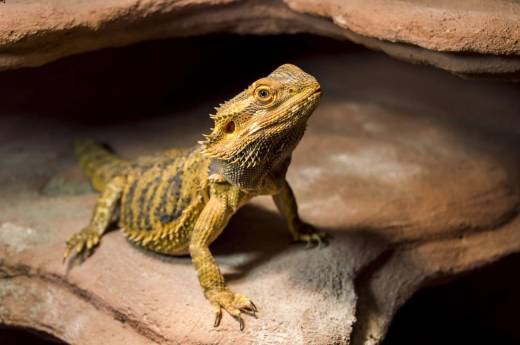Connect with a verified veterinarian in minutes. Licensed vets are available 24/7 to answer your questions. No need to worry about your furry family member.
If you’re new to all things bearded dragons, you may find morphs confusing. So, in this article, we’ll take a look at the different types of bearded dragon morphs—their colors and patterns. Let’s get started!
What is a Bearded Dragon Morph?
Bearded dragon morphs refer to the different traits that bearded dragons carry. The traits are carried in the lizards’ genes, and they can change the dragon’s colors, appearance, or even skin texture. Because morphs are genetic, they can be determined by dominant, recessive, or codominant genes that are inherited from each bearded dragon’s parents.
When it comes to the genes themselves, a recessive gene can be seen if it’s not repressed by a dominant gene. In the case of codominant genes, these become apparent when both genes are equally dominant. The result, when looking at the bearded dragon, is a combination of both genes.
It’s important to understand that morphs have more to do with appearance rather than color. Though the color can be affected by the morph, the morph may not determine the color of the dragon.
Now, we’re ready to get on with the different bearded dragon morphs!
Bearded Dragon Morphs
There are about 22 bearded dragon morphs, and there are possibly more! In this article, we’ve covered the most common morphs. You’ll see we have 17 morphs listed; however, you’ll find 4 morphs listed under the yellow and orange bearded dragon morphs, which means we have about 21 morphs in this article!
1). Classic/Normal
A normal morph looks very much like the wild bearded dragons. These are sometimes also referred to as “wild-type.” Their coloration is sandy brown or tan, which is used as camouflage by wild dragons.
They have triangular heads, spiky beards, and spikes running down their back and sides. Some may also have a different pattern, such as a “tiger” pattern, which is the most common.
2). Red Bearded Dragon Morphs
While some wild bearded dragons do have red specks, the only bearded dragons that are entirely red are those that have been bred in captivity.
The red colors vary from vivid red all the way to brownish shades of red. And there are ruby red dragons, too. Red and ruby morphs are the two most popular; they’re also the most expensive compared to other morphs.
3). Translucent Bearded Dragon
This is an interesting morph. These bearded dragons have transparent spikes and scales. The babies even have clear blue stomachs!
Translucent dragons usually have very dark black eyes. However, their eyes do change all through their lives from yellow to black again.
Blue and purple bearded dragons are very rare.
4). White Bearded Dragon
White bearded dragons, also called snow bearded dragons, are very rare morphs. These lizards lack pattern and color. What’s more, their color can vary to gray when they’re cold or all white when they’re warm.
The parents of the white morph are a snow bearded dragon and a witblit bearded dragon (patternless morph).
5). Black Bearded Dragon Morphs
Black bearded dragons have more pigment in their skin, which gives them a darker appearance. However, these completely black bearded dragons are extremely rare.
6). Albino Bearded Dragon
An albino bearded dragon is a true albino—his skin and eyes do not produce pigment. This means his skin is white, and his eyes are red.
Albino bearded dragons can be more naturally; however, they don’t live long. This is because they’re not able to absorb UVB rays to process calcium efficiently.
If you see an albino bearded dragon for sale, it’s probably not a true albino. Instead, the breeder may have made a mistake. They may actually have a snow beardie or a white beardie rather than an albino.
7). Yellow Bearded Dragon Morphs
Yellow bearded dragons actually come in four types:
- Citrus: the most popular of the yellow morphs, they have dark orange-red stripes down the center of their back and along the sides of their body.
- Green: these are citrus morphs who are olive or green as hatchlings. Those that retain their green color as an adult are called green bearded dragons.
- Lemon fire: are not as popular as the citrus morphs; they’re a very bright yellow color.
- Sandfire gold: these bearded dragons have a tan-like coloring, with stripes across their body.
8). Orange Bearded Dragon
These dragons are produced by yellow and red bearded dragon morphs. The orange beardies are some of the most distinctive morphs in captivity. The most common orange morphs include:
- Orange
- Tangerine
- Sandfire
- Sunburst
9). Leatherback Bearded Dragon
These dragons are scalation morphs. Leatherbacks have smooth scales and are bred from heterozygous genes. They don’t have spikes on their limbs or backs. Instead, they have spikes only on the sides of their body.
10). Paradox Bearded Dragon
The paradox dragon is specially bred for their distinctive pattern along their tail and back. They have unique patterns and irregular patches of color. In addition, they have tiger stripes that are horizontal, orange, and gray along their backs.
11). Hypomelanistic Morph
This is a type of bearded dragon that has “below normal color,” which means the dragon has a pastel coloration. These morphs don’t have dark patterns or colors. And their nails are clearer than other morphs.
12). Silkback Morph
This is a very unique bearded dragon morph. The silkback has no spines like other bearded dragons. Instead, they have smooth skin and bright colors. They’re also sometimes called “silkies” because their skin feels so soft.
13). German Giant Morph
The German giant morph strongly resembles the classic or standard morph; however, they’re very large.
14). Dunner Morph
This morph is named after the breeder who created them. The Dunner morph looks very similar to the classic morph, but their scales don’t have an obvious pattern. So, the markings seem to go in a haphazard direction rather than in the bearded dragon’s typical stripes.
15). Zero Morph
The zero morph is very rare. They’re called “zero” because they completely lack any colors or patterns.
16). Witblits Morph
These are another type of hypomelanistic dragon. They have a very pale color, with no patterns. They can, however, come in a variety of solid colors.
17). Wero Morph
This is a combination of the zero and witblits morphs. The wero morph may resemble the zero, but it has splotches of darker colors near the tail.
There you have it! Bearded dragons can come in a wide range of colors and patterns. Even so, we have to say that each one is beautifully unique, no matter which one you prefer.
Connect with a verified veterinarian in minutes. Licensed vets are available 24/7 to answer your questions. No need to worry about your furry family member.

Tom
Tom has always loved to write since he was little - he wanted to be either a writer or a veterinary doctor, but he ended up being a professional writer while most of his works are based on animals. He was born in San Francisco but later moved to Texas to continue his job as a writer. He graduated from the University of San Francisco where he studied biotechnology. He is happily married and a soon to be father!
Review symptoms, medications & behavior to keep your pets healthy with a Vet Online in just minutes.
Ask a Vet Live Now




